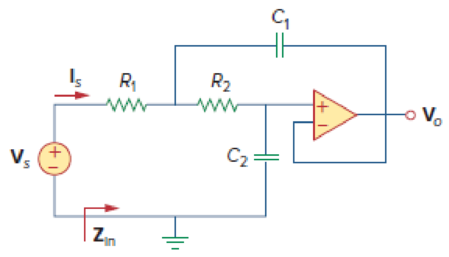
Concept explainers
If the input impedance is defined as Zin = Vs/Is, find the input impedance of the op amp circuit in Fig. 10.116 when R1 = 10 kΩ, R2 = 20 kΩ, C1 = 10 nF, C2 = 20 nF, and ω = 5000 rad/s.

Figure 10.116
Calculate the input impedance
Answer to Problem 73P
The value of input impedance
Explanation of Solution
Given data:
Refer to Figure 10.116 in the textbook for the op amp circuit.
The values of resistance
The values of capacitance
The value of angular frequency
Formula used:
Write the expression to calculate impedance of the capacitor.
Here,
Write the formula for input impedance of the given op amp circuit.
Here,
Calculation:
Substitute
Substitute
The frequency domain representation of given circuit with the node voltage is shown in Figure 1.

Apply Kirchhoff’s current law at node
According to the properties of an ideal op amp, the voltage appear across the input terminals of the op amp is zero.
The voltage at the inverting terminal will be appear at the non-inverting input terminal. Since the output voltage is fed back to the inverting terminal, the voltage
Substitute equation (4) in (3).
Reduce the equation as follows.
Apply Kirchhoff’s current law at node
Substitute equation (5) and (7).
Simplify the equation as follows.
Substitute equation (7) in (5).
Simplify the above equation as follows.
Substitute equation (8) in (7).
From Figure 1, write the expression for current
Substitute equation (10) in (2).
Conclusion:
Thus, the value of input impedance
Want to see more full solutions like this?
Chapter 10 Solutions
Fundamentals of Electric Circuits
- A lighting load of 600 kW and a motor load of 707 kW at 0.707 p.f lagging are supplied by two alternators running in parallel. One machine supplies 900 kW at 0.9 p.f lagging. Find the load sharing and p.f of second machine?arrow_forwardPlease draw out the circuitsarrow_forwardQ2 but when you get to part 3, can you please draw it outarrow_forward
- please solve manually. I need the drawing and the values too. Thank you!arrow_forwardTwo alternators, Y-connected 6.6 kV supply a load of 3000 kW at 0.8 p.f lagging. The synchronous mpedance of first alternator is (0.5+j10) Q/ph and second alternator is (0.4+j12) /ph. First alternator delivers 150 amp at 0.875 lag p.f. The two alterators are shared load equally. Determine the current, p.f., induced e.m.f, load angel, and maximum developed power of each alternator?arrow_forwardA domestic load of 2300 kW at 0.88 p.f lagging and a motors load of 3400 kW at 0.85 p.f lagging are supplied by two alternators operating in parallel. If one alternator is delivering a load of 3300 kW at 0.9 p.f lagging, what will be the output power and p.f of the other alternator?arrow_forward
- Determine the value of Rr that necessary for the circuit in Fig.(2) to operate as an oscillator and then determine the frequency of oscillation. 0.001 F 0.001 F 0.001 F R₁ • 10 ΚΩ R₁ 10 k R • 10 ΚΩarrow_forward(a) For the circuit shown in Figure Q3(a) (RFC and Cc are forbias) (i) (ii) Draw the AC small signal equivalent circuit of the oscillator. From this equivalent circuit derive an equation for fo and the gain condition for the oscillations to start. VDD www RG eee RFC H Cc 北 5 C₁ L 000 C₂ Voarrow_forwardPlease solve this question step by step handwritten solution and do not use chat gpt or any ai toolsfor part ii) you may need to use nodal analysisarrow_forward
- 12.1. Find the steady-state response vo (t) for the network. 00000- 1Ω ww 12 cos(t) V + www 202 1 H 202 1 F + 1Ω νο -arrow_forwardA Three-phase, 12 pole, Y-connected alternator has 108 slots and 14 conductors per slot. The windings are (5/6 th) pitched. The flux per pole is 57 mWb distributed sinusoidally over the pole. If the machine runs at 500 r.p.m., determine the following: (a) The frequency of the generated e.m.f., (b) The distribution factor, (c) The pitch factor, and (d) The phase and line values of the generated e.m.f.?arrow_forwardTwo 3-ph, 6.6 kV, Y-connected, alternators supply a load of 3000 kW at 0.8 p.f. lagging. The synchronou impedance per phase of machine A is (0.5+110) and that of machine B is (0.4 +J12) . The excitation of machine A adjusted so that it delivers 150 A. The load is shared equally between the machines. Determine the armature curre p.f., induced e.m.f., and load angle of each machine?arrow_forward
 Delmar's Standard Textbook Of ElectricityElectrical EngineeringISBN:9781337900348Author:Stephen L. HermanPublisher:Cengage Learning
Delmar's Standard Textbook Of ElectricityElectrical EngineeringISBN:9781337900348Author:Stephen L. HermanPublisher:Cengage Learning
